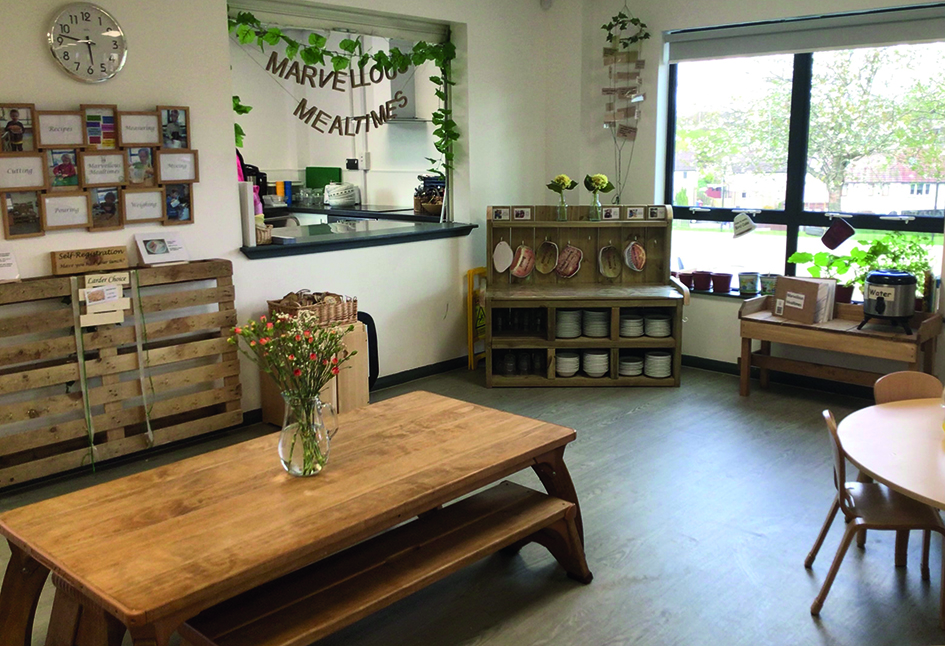
Mealtimes can sometimes feel like another routine to be rushed through, and sometimes the least enjoyable for adults and children. Yet if we apply the ideas of a slow pedagogy, mealtimes and snacktime are an important part of the day to be valued in their own right.
Mealtimes can be a social time where relationships can be strengthened, conversations shared, nourishing food enjoyed and for children to develop new skills. This takes time.
A key ingredient when thinking about what this means in practice is questioning how children can play an active role in the process, finding more ways to develop their skills, confidence and enjoyment in an unhurried environment.
Here are some ideas based on examples from workshops with practitioners in Orkney, Shetland and Falkirk in Scotland.
SNACKTIME
- Involve children in choosing and buying food. A small group could go on a walk each week to choose and buy fruit and vegetables. Children can be involved in ‘drawing’ the shopping list or choosing from picture cards.
- Children can take turns to help prepare food for snacktime, developing their fine motor skills as well as joining in this social activity together.
- Try different ways of planning snacktime. Here are two options:
- A ‘rolling snacktime’, where food is available for children to help themselves over a longer period, may help children to have more uninterrupted periods of play.
- An arranged snacktime for children to gather with an adult in a small group may be the opportunity to press pause for shared conversations.
- Children can be involved in growing vegetables, experiencing the great patience needed to water and care for plants.
MEALTIMES
- How can children be involved in preparing, serving themselves and tidying away? Ingrid Devine, senior practitioner at Scalloway Early Years, Shetland, says, ‘The children are growing in confidence as they make choices from start to finish. Lunchtime has become a social event and the rich language which develops from the adult/child interactions supports unhurried learning. Routines and processes become autonomous when the children are choosing their own food and loading the dishwasher.’
- How do furniture and utensils support all children’s active engagement in mealtimes, including children with special needs? For example, what difference could it make to the youngest children in highchairs if they could join older children and adults at a shared table?
- Where is lunch happening? Noise can be a factor in making lunchtimes rushed. In school settings, for example, lunches in classrooms rather than a hall may make lunches quieter.
CASE STUDY: slow practices at mealtimes in Falkirk
 Two early years settings in Falkirk decided to focus on mealtimes as a slow practice. This built on the successful Marvellous Mealtimes project co-ordinated by Gemma Paterson. Practitioner Tracey Sharples explains that small changes made a big difference, for example, buying jugs and serving tongs that were easier for the children to handle themselves. Practitioners discussed how mealtimes could become more in keeping with their vision for children as autonomous learners. Tracey continues: ‘It really was stepping back and allowing our children to be the little independent people that we know they are. And you could see any negative behaviours kind of dwindled away.’
Two early years settings in Falkirk decided to focus on mealtimes as a slow practice. This built on the successful Marvellous Mealtimes project co-ordinated by Gemma Paterson. Practitioner Tracey Sharples explains that small changes made a big difference, for example, buying jugs and serving tongs that were easier for the children to handle themselves. Practitioners discussed how mealtimes could become more in keeping with their vision for children as autonomous learners. Tracey continues: ‘It really was stepping back and allowing our children to be the little independent people that we know they are. And you could see any negative behaviours kind of dwindled away.’
There was a different rhythm created for this part of the day, with attention paid to how the physical environment could become a more inviting space for eating together. This had a ‘ripple effect’ spreading out to other parts of the day, with educators thinking about how a less-hurried approach could be sustained.
What is slow pedagogy?
Slow pedagogy is an unhurried approach that aims to be more conscious of the relationship with time and its impact on both young children and practitioners. It is about valuing the present moment and being attentive to children’s pace, rhythm and interests.
A slow pedagogy enables children to revisit their ideas and creations, places and stories, and creates opportunities for children to go deeper in their learning. Support is given for time for observation, listening, reflection and documentation.
MORE INFORMATION
- Slow pedagogy and Froebelian principles: https://www.froebel.org.uk/training/films/slow-pedagogy
- Clark A. (2023) Slow Knowledge and the Unhurried Child: Time for slow pedagogies in early childhood education. Routledge









